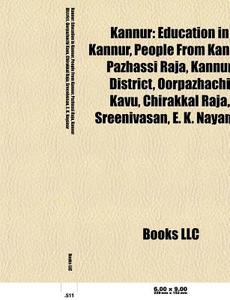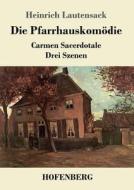
Kannur
Kannur district, Oorpazhachi Kavu, Rajarajeshwara Temple, Cherukunnu, Chirakkal Raja, Cherupuzha, Krishi Vigyan Kendra Kannur, Ali Raja, Parassinikkad
- Editore:
Books LLC, Reference Series
- EAN:
9781155964706
- ISBN:
1155964705
- Pagine:
- 48
- Formato:
- Paperback
- Lingua:
- Inglese
Descrizione Kannur
Source: Wikipedia. Pages: 46. Chapters: Kannur district, Oorpazhachi Kavu, Rajarajeshwara Temple, Cherukunnu, Chirakkal Raja, Cherupuzha, Krishi Vigyan Kendra Kannur, Ali Raja, Parassinikkadavu, Valapattam, Muthappan Temple, St. Angelo Fort, Kannur Railway Station, Mambaram, Cannanore Lighthouse, Valapattanam River, Koodali, Arakkal Museum, Cannanore Cantonment, Mayyil, Payyambalam Beach, Thayatheru, Mappila Bay, Thottada Beach, Thavakkara, Kannur Town, Kannur Municipality. Excerpt: Kannur District (Malayalam: ) is one of the 14 districts in the state of Kerala, India. The town of Kannur is the district headquarters, and gives the district its name. The old name Cannanore is the anglicised form of the Malayalam name Kannur. Kannur District is bounded by Kasaragod District to the north and Kozhikode District and Wayanad District to the south. To the east the district is bounded by the Western Ghats, which forms the border with Karnataka state, in its districts of Kodagu and Chamarajanagar. The Arabian Sea lies to the west. Kannur is the most urbanised district in Kerala, with more than 50% of its residents living in urban areas. Kannur has an urban population of 1,212,898, which is the second largest in Kerala after Ernakulam district. Kannur District is known as the land of looms and lores, because of the loom industries functioning in the district and festivals held in temples. The district is a major centre of Theyyam, a ritual dance of northern Kerala. Small shrines known as kavus associated with the Theyyam dot the district. The district is set to have a new international airport, the fourth in Kerala. A view of Arabian Sea from St. Angelo's Fort, KannurThere are many myths and legends behind the name Kannur. It is said to be a portmanteau derived from two Malayalam words, 'Kannan' (Krishna), a Hindu deity, and 'Ur' (place), making it the place of Lord Krishna. One support for this theory is that the deity of the Kadalayi Srikrishna Temple was originally installed in a shrine at Kadalayi Kotta in the southeastern part of the present Kannur town. During British Raj, the city was known as Cannanore, the Portuguese version of its ancient name, 'Kannanore'. The earliest evidence of human habitation in the district are rock-cut caves and megalithic burial sites of the Neolithic age. The Taliparamba-Kannur-Thalassery area abounds in rock-cut caves, dolmens, burial stone circles and menhirs, all of megalithic burial order. The district was part of




